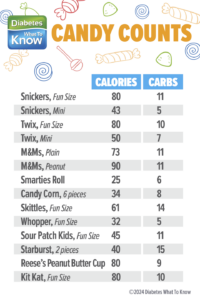By Melinda Maryniuk, MEd, RD, CDCES
Halloween has turned into a whole season of temptations, not just a single night, and it can be really hard for anyone who’s trying to eat healthier. Here are a few tips and tricks to help manage the treats.
Wait to buy candy. Plan to buy the treats you want to give out just a day or two before Halloween so you’re not tempted by candy in the house for weeks before the 31st.
Offer healthier treats. Mini-bags of nuts, granola bars, snack chips, raisins or popcorn might end up being the treats that kids can actually keep and eat! In an effort to reduce the junk food, many parents are now limiting the amount of candy they allow their kids to eat.
Buy your least favorite candies. There is no rule that says you have to give out your personal favorites. Reduce the risks to snack by purchasing the treats you could care less about.
Sugar-free? Pros and cons. You might think you’re doing yourself a favor by buying candies labeled “sugar-free”. Not necessarily. These products use an artificial sweetener or sugar alcohol (such as maltitol, xylitol or something else ending in an –ol). While this type of sugar does have less of an effect on blood glucose (and contributes to only about half of the carb calories), eating a few too many can make your tummy rumble… and lead to diarrhea. Sugar-free candies containing chocolate will normally still have the same amount of fat – and sometimes more than their non-sugar free counterparts. Example? 3 mini sugar-free peanut butter cups = 90 calories and 6.6 grams fat. 3 mini regular peanut butter cups = 84 calories and 6 grams fat. Which do you choose? (I’ll have the regular, thank you!)
Plan a give-away. You’ll likely have leftovers, so instead of keeping a candy bowl filled “just in case the grandkids drop by” plan where you can bring the candy. Bring it to the office break room, to a local shelter, soup kitchen, or a retirement home. Some dental offices participate in candy buy-back programs, and there are also websites where you can learn how to send candy to those in the armed services. Check out www.operationgratitude.com & www.halloweencandybuyback.com.
Count the carbs. If you’re going to eat some Halloween candy, then plan for it and enjoy it. Ideally, pick your very favorite, savor it slowly and don’t feel guilty. Since the “fun size” and “mini” (even smaller versions) sold at Halloween don’t have label information on the wrappers, here’s a guide to some of the favorites:

Bring a Halloween-themed treat. The best way to avoid the many temptations at the neighborhood party is to bring something you know is tasty and diabetes-friendly. Stuff a hollowed out mini-pumpkin with guacamole or a yogurt dip and serve with baby carrots. Make a batch of pumpkin spice muffins. Your friends will appreciate that you’re thinking about their health, too!
Recipe for Pumpkin Spice Muffins:
(Recipe adapted from Diabetes Forecast)
Makes: 16 mini-muffins
Serving Size: 2 mini-muffins
Ingredients:
1 cup whole wheat flour
3 tsp. baking powder
2 tsp. ground cinnamon
1 tsp. pumpkin pie spice
1 egg beaten
2 Tbsp. brown sugar stevia (Truvia)
1 cup canned pumpkin
½ cup nonfat milk (I used 1%)
¼ cup unsweetened applesauce
¼ cup raisins (or could use chopped nuts, or skip altogether)
Directions:
Preheat the oven to 400°F. Line 16 mini-muffin-pan cups with paper liners or spray with nonstick cooking spray. In a large bowl, stir together the flour, baking powder, and spices. In a medium bowl, stir together the beaten egg, Truvia, pumpkin, milk, and applesauce; stir until well blended. Stir the raisins or chopped nuts into the flour mixture until just blended. Fill the muffin-pan cups 2/3 full. Bake 20 to 25 minutes, or until a wooden toothpick inserted in the center comes out clean. Remove the muffins from the pans. Serve warm or at room temperature.
Nutrition Information:
Per 2 muffins: 95 calories, 20 grams carb, 3 grams fiber
The medical information on Diabetes – What To Know’s website is provided as an information resource only. The content is not in any way intended to be nor should you rely on it as a substitute for professional medical evaluation, diagnosis, advice and treatment.

